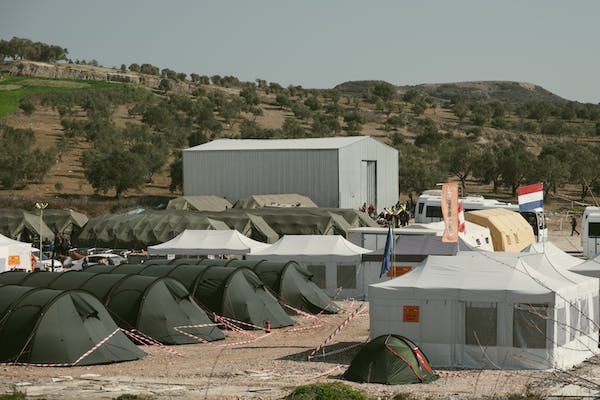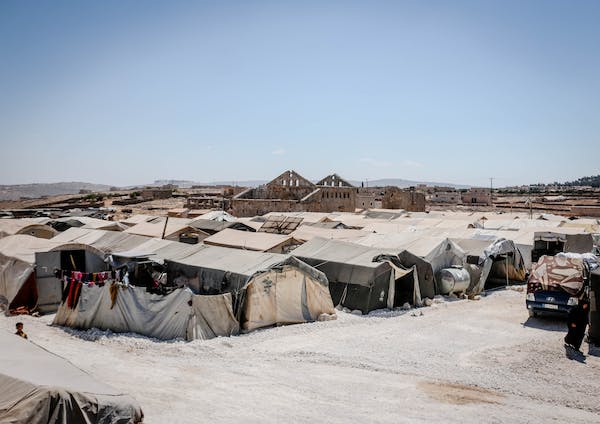Introduction

The status of Refugee Camps
Refugee camp; The humanitarian crisis in Africa has been exacerbated by the constant influx of refugees seeking safety and shelter. The continent, the largest in the world, remains home to some of the largest and most vulnerable refugee populations. Over the years, refugee sites have been established to help provide shelter, basic needs, and protection to those fleeing conflict and persecution. In 2000, these camps were identified as the best areas for saving lives in Africa.
Protection for Displaced
One of the significant advantages of refugee is that they offer a form of protection to the displaced individuals. They provide a stable environment where people can access basic needs such as food, shelter, water, and health care services. The camps are usually situated in remote areas far away from conflict zones, making them a safer option for refugees. In 2000, these camps were hailed as the best areas to save lives in Africa because they offered the necessary protection that refugee populations needed at a time of crisis.
Aid Services
Another reason why refugee camps were considered the best areas for saving lives in Africa is that they allow for the delivery of aid services in a systematic, coordinated and effective manner. With thousands of refugees in need of help, it can be challenging to ensure that aid reaches everyone who needs it. However, within a refugees camp, aid agencies can work together to ensure that basic needs are met, and emergency response activities are delivered with efficiency. This coordinated approach ensures that the limited resources available are utilized effectively and efficiently, saving more lives.
Platform for Solution
Refugees camps can also provide a platform for the delivery of long-term solutions to refugees. These long-term solutions help to address the underlying causes of the refugee crisis, such as poverty, conflict, and persecution. Such solutions could include education, vocational training, and job creation programs. In 2000, refugee camps were seen as an opportunity for governments, development agencies, and NGOs to work together to provide sustainable solutions beyond the provision of emergency services.
Camps are not Perfect Solution
However, it is essential to acknowledge that refugees camps are not a perfect solution. They can be overcrowded, under-resourced, and the provision of basic services can be inadequate. There have also been cases of sexual exploitation and abuse within refugees camps. Additionally, refugees may face discrimination and exclusion from host communities, making reintegration into society a significant challenge. Therefore, while refugees camps are the best areas for saving lives in Africa, they should not be seen as a long-term solution, and other alternatives such as resettlement should be explored.

Refugee Camps in Europe in 2000s
Refugees camps in Europe in the 2000s were an unfortunate reality for many who had fled their home countries due to conflict, persecution, and other factors. These camps were often hastily constructed to accommodate large numbers of refugees in a short amount of time, and conditions were often cramped and unsanitary. While some of these camps were administered by governments or international organizations, others were run by local NGOs and volunteers.
Legal Protection
One of the biggest challenges facing refugees in Europe in the 2000s was the lack of legal protection and support. Many refugees found themselves in limbo, unable to work or access basic services due to their precarious legal status. This made it difficult for many to rebuild their lives and move on from their traumatic experiences. Additionally, there were often tensions and conflicts within refugee camps between different ethnic and religious groups, as well as with local residents who felt that their communities were being overwhelmed by newcomers.
Solidarity and Compassion
Despite these challenges, there were also many acts of solidarity and compassion demonstrated by Europeans towards refugees. Many people volunteered their time and resources to support these communities, and there were numerous grassroots initiatives aimed at providing education, healthcare, and other vital services. While the situation for refugees in Europe in the 2000s was far from ideal, it is important to recognize the resilience and determination shown by those who had fled war and persecution in search of a better life.
The Contribution of IMO In People’s Development
The International Maritime Organization (IMO) is a specialized agency of the United Nations responsible for promoting maritime safety, security, and environmental sustainability. Throughout its existence, IMO has played a crucial role in global development, fostering economic growth, ensuring the safety and well-being of seafarers, and protecting marine ecosystems. This essay will explore the vast contribution of IMO in promoting people’s development across various spheres.
Enhancing Global Trade
IMO’s fundamental role in facilitating international trade cannot be overstated. Through the establishment and implementation of robust international maritime regulations, such as the International Convention for the Safety of Life at Sea (SOLAS), IMO has nurtured a safe and secure global shipping industry. This has contributed significantly to the expansion of international trade, fostering economic development in countries around the world.
Preserving Marine Environment
IMO has been at the forefront of promoting the sustainable use of oceans and the preservation of marine ecosystems. Its initiatives, such as the International Convention for the Prevention of Pollution from Ships (MARPOL), have contributed to reducing pollution and protecting marine biodiversity. By raising awareness and working with member states to enforce environmentally-friendly practices, IMO has significantly contributed to the development of sustainable marine industries.
Protecting Seafarers’ Rights and Welfare
Seafarers are the backbone of the shipping industry, and IMO has consistently advocated for their rights and welfare. Through the Maritime Labour Convention (MLC), IMO sets out comprehensive standards to ensure decent working and living conditions for seafarers worldwide. By enforcing these standards, IMO has contributed to the social development of maritime workers, safeguarding their well-being and ensuring their fair treatment.
Promoting Gender Equality
IMO has taken an active stand in promoting gender equality within the maritime sector. Recognizing the underrepresentation of women in the industry, the IMO has launched initiatives, such as the Women in Maritime program, aimed at empowering women in maritime professions. By championing equality and creating opportunities, IMO has fostered the development of inclusive and diverse maritime communities.
Enhancing Maritime Security
IMO plays a key role in ensuring maritime security, particularly in combating maritime piracy, terrorism, and smuggling. Its regulatory framework, including the International Ship and Port Facility Security (ISPS) Code, enhances the safety and security of international shipping. By promoting secure maritime trade routes, IMO has contributed significantly to the stability and development of both coastal and landlocked nations.
Facilitating Technological Advancements
IMO actively encourages technological innovations that improve shipping efficiency while reducing the sector’s environmental impact. Through initiatives like the Global Maritime Distress and Safety System (GMDSS), IMO has facilitated the development and implementation of advanced communication and navigation technologies, promoting safer and more sustainable maritime operations.
Developing Human Resources
IMO recognizes the importance of robust human resources in the maritime sector. It has contributed significantly to the professional development and training of seafarers through programs like the International Convention on Standards of Training, Certification, and Watchkeeping for Seafarers (STCW). By ensuring the availability of a well-trained workforce, IMO has supported the human capital development of the maritime industry.
Addressing Climate Change Challenges
IMO has been proactive in addressing climate change challenges in the maritime sector. Recognizing the need to reduce greenhouse gas emissions, IMO adopted the Initial IMO Strategy on reduction of GHG emissions from ships. By setting ambitious targets and promoting energy-efficient shipping technologies, IMO has played a crucial role in developing a sustainable and environmentally responsible global maritime industry.
Strengthening International Cooperation
IMO serves as a platform for international cooperation, fostering dialogue and collaboration among member states, governments, and industry stakeholders. Through various committees and meetings, IMO promotes the exchange of knowledge and best practices, contributing to the overall development of the maritime sector globally.
The International Maritime Organization’s multifaceted contributions to people’s development across different domains cannot be underestimated. From ensuring maritime safety and security to preserving the marine environment and promoting gender equality, the IMO has played a pivotal role in shaping the global maritime industry. Its efforts in developing human resources, embracing technological advancements, and addressing climate change challenges have further contributed to sustainable development worldwide. Through its commitment to international cooperation, IMO continues to enhance global trade and harmonize maritime regulations, positively impacting the lives and well-being.

How Many Refugees Are There in the World This Year?
The issue of global refugee populations has become increasingly prevalent in the modern era. From countries riddled by armed conflicts to those impacted by political instability and environmental disasters, millions have been forced to flee their homes in search of safety and a better future.
Defining Refugees
To commence our analysis, it is essential to define the term “refugee.” Refugees, as defined by the United Nations High Commissioner for Refugees (UNHCR), are individuals who have been compelled to flee their home countries due to well-founded fears of persecution based on their race, religion, nationality, political opinion, or membership in a particular social group.
Sources of Data
Accurately quantifying the number of refugees worldwide is a challenging task. The primary source for such statistics is the UNHCR, which collects data from governments, NGOs, and other relevant institutions. They ensure consistency and reliability in their reports to provide an accurate representation of the global refugee situation.
Current Global Refugee Statistics
As of the present year, 2022, the global number of refugees remains staggering. According to the most recent UNHCR report released in June 2022, there are approximately 82.4 million forcibly displaced persons worldwide. This includes refugees, asylum-seekers, and internally displaced persons (IDPs).
Refugee Trends and Explanatory Factors
Understanding the reasons behind the increasing number of refugees is crucial for comprehending the global refugee crisis. Factors such as armed conflicts, political unrest, ethnic tensions, economic disparities, climate change-induced environmental disasters, and human rights violations all contribute to the displacement of individuals and families.
Regional Distribution
The distribution of global refugees is not uniform. Different regions bear varying burdens of displacement. As of this year, Sub-Saharan Africa hosts the highest number of refugees, accounting for approximately 26% of the global total. The Middle East and North Africa follow closely, hosting around 20%. Asia, Europe, and the Americas also accommodate significant refugee populations.
Large-Scale Conflicts and their Impact
Several ongoing global conflicts have played a significant role in the displacement of millions. The Syrian conflict, now in its twelfth year, alone has resulted in millions fleeing their homes. Additionally, long-standing conflicts in Afghanistan, South Sudan, Myanmar, and the Democratic Republic of Congo contribute significantly to the global refugee crisis.
Forced Displacement and Protracted Refugee Situations
An alarming aspect of the current refugee situation lies in the duration of displacement. Many refugees find themselves trapped in protracted situations, with their temporary displacements extending for years or even decades. This perpetuates vulnerability, deprives individuals of essential rights and opportunities, and makes durable solutions more elusive.
Addressing the Global Refugee Crisis
Effectively addressing the global refugee crisis requires a multi-faceted approach. It involves ensuring international protection, promoting conflict resolution and peacebuilding, addressing root causes, providing humanitarian aid, and supporting integration efforts in host countries. Such measures can contribute to stabilizing the lives of refugees and fostering long-term solutions.
Psychosocial and Humanitarian Challenges
The predicament faced by refugees reaches beyond physical displacement. Mental health concerns, trauma, inadequate living conditions, limited access to education and healthcare, and discrimination are among the many humanitarian challenges that refugees encounter. Addressing these issues holistically is paramount to ensuring the well-being and successful integration of refugees into host societies.
The global refugee crisis is a pressing issue that demands attention and comprehensive solutions. As of this year, approximately 82.4 million individuals worldwide have been forcibly displaced. Understanding the magnitude of the crisis, recognizing regional disparities, and factoring in the causes and consequences are fundamental steps toward creating a more compassionate, inclusive, and equitable world for all displaced persons. By addressing both the immediate needs and long-term challenges faced by refugees, we can foster an environment of understanding, support, and resilience that will benefit us all.

Conclusion on Refugee Camp
In conclusion, refugee sites remain the best areas for saving lives in Africa, particularly in times of crisis. They provide a safe environment for refugees, allow for effective coordination of aid activities, and provide an opportunity for long-term solutions. However, it is essential to recognize that refugees sites are not without challenges and that alternative solutions, particularly those aimed at addressing the root causes of displacement, should also be explored.

2 thoughts on “Are Refugee Camps The Best Areas for Saving Lives in Africa in 2000s?”